|
|
Many uprooted Armenians were forced to travel on
foot to the locations they were being transferred to. Was this so that the
"extermination plan" could be made easier?
The U.S. Consul in Mersin, Edward Natan, said in an
August 30, 1915 report to Ambassador Morganthau that the railway route from
Tarsus to Adana was full of Armenians; and that they traveled from Adana
onwards with a ticket; and despite some difficulties due to crowds of people,
the government organized this process in the most orderly fashion; and that
the Government did not allow any act of violence or disorder, provided
sufficient number of tickets to the immigrants and assisted those who were in
need.
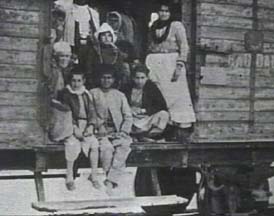 |
|
Armenians being transferred by rail; from the PBS
show, "The
Great War"
|
So we know Armenians were transported by rail, and given
that the limited rails were used for war efforts and were congested, the
process must still not have gone too badly, since most Armenians made it to
their destinations (over 500,000, satisfied, and even going about making their
livings, as an Armenian representative reported to Ambassador Morgenthau, in Sept. 1915).
Unfortunately, this was the bankrupt "Sick
Man," and the railways only went so far. As Arthur Tremaine Chester elaborated, "The
Turkish Government ordered the Armenians deported from the districts they
menaced That they did not have railways and other means of transportation was
not their fault, and the deportation had to be carried out on foot. That this
was not done in the most humane manner possible is undoubtedly a fact, and the
Turkish Government has condemned the unnecessary cruelties that
occurred."
It was when the unfortunate Armenians travelled on foot
that massacres occurred, often by lawless bands. For example, when missionary
Mary Graffam accompanied a
convoy from Sivas, she reported that the ones doing the attacking were the
Kurds. Others, too, behaved criminally, including Circassians, Arabs, and
Turks as well.
But this was not a situation that was created to make
life difficult for the Armenians. Dadrian theories like Special Organization forces lying in wake
aside, this was just... the way. Marching, in areas without railways, was the
only means available for large groups of people, to get from Point A to Point
B.
Even Turkish soldiers had to resort to such a primitive
means of transportation.
Why don't we resort to the epic motion picture, LAWRENCE
OF ARABIA, to get the idea of what it must have been like?
|
|
|
| |
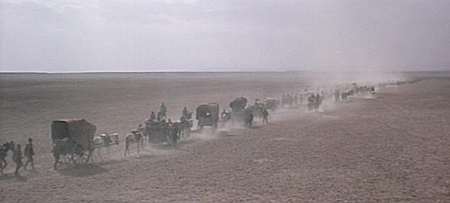
There goes the Turkish force, on foot, under the hot desert sun.
(And this was not the kind of desolate desert the Armenians were transferred to, as
Armenian propaganda would have us believe; Armenians were moved to areas known as
"The Fertile Crescent.")
|
|
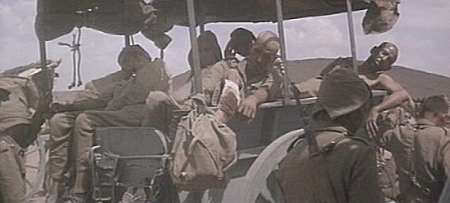
The soldiers are exhausted or wounded, hungry
and thirsty
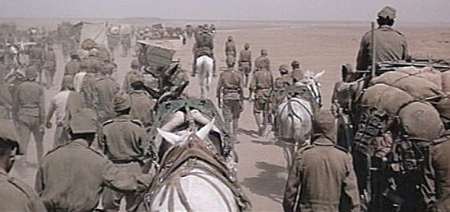
|
| |
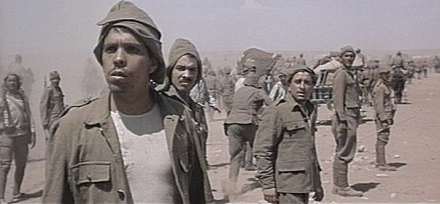
Uh-oh! The film's "Arab extras" take note of the impending
trouble
|
|
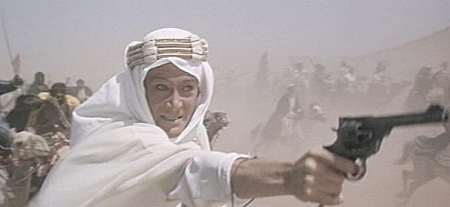
It's that darned Lawrence of Arabia, ordering
"NO PRISONERS!," and 2,000 Arabs, swinging swords
|
| |
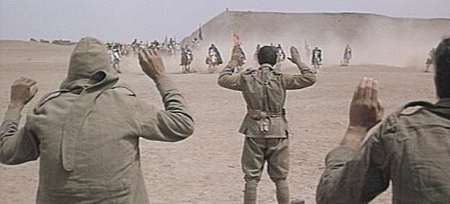
Lawdy! They came out of nowhere. Not much to do
but surrender...
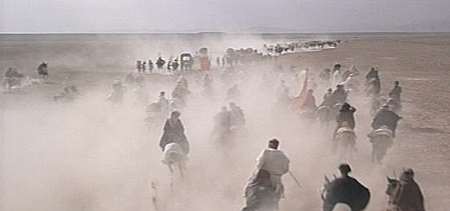
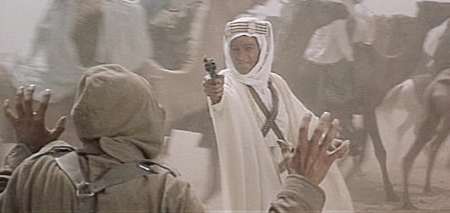
It's a complete massacre. And all because José
Ferrer had his way with the fair Lawrence.
|
| |
Sure, these were soldiers, and neither the Arab
rebels nor the Ottoman forces were respecting the Geneva Convention, as they went at each
other. We're not comparing the lot of these men with those of defenseless, innocent
civilians. (Yet, as is painfully clear, even soldiers can be pretty defenseless, and cut
down like sheep.)
The point here is, when you have partisan, "chette"
bands with violence on their minds, there really wasn't much that could be done. They
suddenly swooped down, and had their way. The only way to have minimized such pain with
the Armenians would have been to make sure the convoys were guarded with enough gendarmes,
behaving professionally. Unfortunately, there was a critical shortage of such manpower...
and what took precedence was that the Armenians had to be moved away, since the Armenians
were too rebellious to remain where they were, during a desperate life and death struggle
threatening the existence of the nation itself. So the Armenians were moved out without
adequate protection, which the Ottoman government certainly bore responsibility for.
This is the way the armed Armenian bandits had their
way in defenseless villages, when nearly every able-bodied "Turkish" man was
away at the multiple fronts. Colonel Wooley of the British Army estimated the Armenians
had done away with 300,000-400,000 Ottoman Muslims in just such a fashion, in Van and
Bitlis alone. (As recorded in the U.S. Archives, 12.9.1919, 184.021/265.) The Ottomans
were just as inefficient with protecting these Muslim people, as well. (Of course, these
particular victims must have mostly been killed while Armenians and Russians were in
control. But there were plenty of examples of such Armenian-directed slaughter on
poorly-guarded Ottoman-controlled lands.)
This is why it is so important to prove, in the case
of massacred Armenians, whether they were victimized by the government on official orders,
or by lawless gangs and other criminals behaving on their own. This is the factor lying at
the very heart of the "genocide" issue.
|
Did Armenians Also Attack Military Convoys, Like the Arabs?
|
Young Armenians, after attacking an army convoy
carrying arms, had succeeded in killing five hundred soldiers who had pursued them. Eventually
the rebels, facing twenty thousand Turkish troops, took refuge in the mountains.
Levon Meguerditchian to Boghos Nubar,
May 28, 1915, in Ghazarian, Boghos Nubar's Papers. p. 65. Guenter Lewy, "The
Armenian Massacres in Ottoman Turkey—A Disputed Genocide," p. 102, 2005
"[T]he Armenian population in the zone of
operations overtly exhibited a common cause with the Russians...some migrating to
Transcaucasia... [and] frequently attacking Turkish convoys."
French General M. Larcher; see footnote 33.
"An armed band headed by a villain by the name of Doryon Dono, from the
Armenian village of Bashnak in the district of Silvan, suddenly attacked on June
28, 1915 a convoy of more than 500 mules carrying goods under the command of
Militia Officer Haci Hamid Effendi, protected by a sufficient number of gendarmes
and militiamen, at a place called Seytan Kaya, while fording a brook, and
cruelly martyred most of them."
From the conclusions of the investigation conducted by the provincial
authority regarding the atrocities committed by Armenians in Diyarbakir and its
environs, as reported in "Archive Documents about the Atrocities and
Genocide Inflicted Upon Turks by Armenians"
|
| Lack
of Transportation for Turkish Troops Most in Need |
All that winter (of 1915-16] sick and wounded Turkish soldiers
came from the front to Mamouret-ul-Aziz. Notwithstanding what we know about the way
Turks treated the Armenians, it seemed incredible that their own soldiers fared better.
They were sent away from Erzerum and other distant places in midwinter, without food and
with little clothing. They were told to go to the hospitals in Mamouret-ul-Aziz, which
were the nearest to them. As no means of transportation was provided, they were obliged
to make the journey of several weeks on foot, begging or stealing something to eat in
the villages through which they passes [sic] and occasionally stealing a donkey on which
to ride. I often met them as they were approaching the town. All but the hardiest ones, of
course, had died on the way... Those who did arrive were often so exhausted that nothing
could be done for them.
Leslie A. Davis, February 9, 1918, reprinted in Sarafian, United
States Official Documents on the Armenian Genocide, vol. 3, pp. 98-99. Similar
descriptions in Jacobsen, Diaries of a Danish Missionary, pp. 48, 52, 59, 161. From
Guenter Lewy, "The Armenian Massacres in Ottoman Turkey—A Disputed
Genocide," p. 57, 2005; the author goes on to write: "Those fortunate enough
to reach the hospitals were not necessarily on the road to recovery, for conditions in
most of those hospitals were horrendous."
Holdwater: What does it say about
Leslie Davis to have known of these awful
conditions affecting everyone, and still have gone on to designate the bad treatment of
Armenians as intentional slaughter, presumably by the government?
|
|